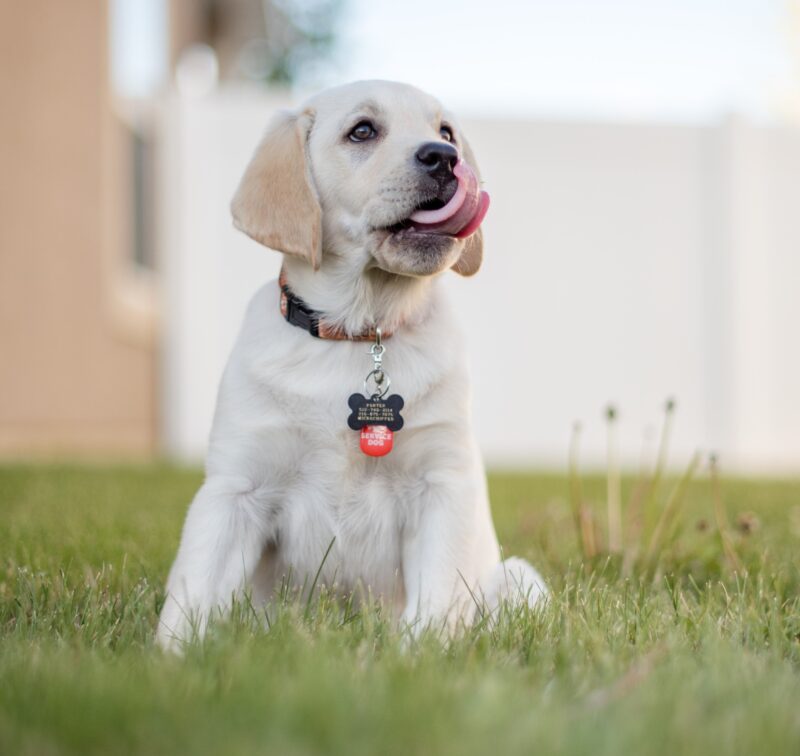Calming signals are universally understood by dogs all over the world – including yours.
Let’s learn what they are and look at the ones you are most likely to see.
What Are Dog Calming Signals?
These signals are used to:
- self-soothe and help them to remain calm.
- ask others to calm down.
- greet others in a friendly way.
There are around thirty signals, but some of the more common and obvious ones you might see are:
- Yawning
- Nose licking / lip licking
- Looking away / turning to face the other direction
- Sniffing the ground
- Moving slowly or freezing
- Curving
We’ll go into more detail and look at others a bit further down.
Most of these behaviors can have other meanings, so you’ll need to take into account the dog’s body language as a whole and the current situation.
Calming Signals vs Stress Signals – Are They The Same Thing?
While there is a lot of crossover between the two terms, they are not exactly the same thing.
A calming signal can also be a sign of stress, but it depends on the situation.
For example, a dog who licks his nose on meeting another dog probably isn’t stressed about the situation and is just using it as a friendly greeting, while a dog that does the same thing while being shouted at most likely is feeling uncomfortable.
There are plenty of stress signals that are not calming signals, for example a loss of appetite or showing teeth.
- Stress Signal: the dog is feeling threatened, scared, worried, uncomfortable or unsure.
- Calming Signal: the dog is trying to calm himself or others, or just showing he is friendly. He’s not necessarily stressed.
Turid Rugaas
In the study of wolves, the signals were referred to as ‘cut-off signals’, as they aim to cut-off any aggressive behavior and stop situations from escalating.
The term ‘calming signal’ was coined by Turid Rugaas, a Norwegian professional dog trainer.
As she studied dog behavior to see if they used cut-off signals as wolves did, she felt that they were used more for preventing rather than cutting off unwanted behavior, and so ‘calming’ would be a more accurate way to describe them.
This article is largely based on her excellent book On Talking Terms With Dogs, which is essential reading for any dog owner. It has many great examples of how these signals can be used by dogs and dog trainers alike.
From Wolf to Dog: The Origin & Purpose of Calming Signals
Dogs are distant relatives of wolves, who are pack animals. Calming signals are a survival behavior wolves use which dogs have held onto.
Packs rely on each other for survival. Conflicts within the pack are very bad as they could lead to one of them getting injured, which would weaken the strength of the pack as a whole.
Wolves therefore developed a whole range of ways to show they are feeling stressed and to politely ask each other to calm down.
When a signal is received, it will be acknowledged with one in return, resulting in a conversation that might go something like this:
“You’re getting a bit aggressive; I don’t want to fight with you as it’s bad for everyone. Would you please calm down a bit?”
“Of course, I only want what’s best for the pack too.”
Sorry for the cheesy dialogue, but hopefully you get the idea. These signals are hugely important for dogs.
They’re so ingrained that they are used by every dog the world over… unless a human, normally unknowingly, tells them they shouldn’t (more on that in a moment).
Calming Signals In Dogs – 19 Most Common
I’ve roughly split these into three categories (movement, face, and body language) which will hopefully make them a bit easier to remember.
Movement
Freezing
The dog will freeze on the spot, not moving a muscle. He may stay like this for a long time, especially if he’s attempting an interaction with another dog that feels wary of him. When he does move again, it will often be very slowly.
Moving Slowly
Similar to freezing, and often following it, moving slowly shows he’s not a threat. Again, this may go on for a while if the other dog is particularly nervous.
Curving
In dog language, walking straight up to another dog, especially at high speed, is considered quite rude and possibly even threatening. Most dogs walk in a curve to come in at the side for a greeting: the wider the curve, the more polite they are being.
Keep this in mind if you are walking down the street with your dog and another is coming towards you in the other direction; there’s a good chance he will feel uncomfortable walking straight ahead and will want to curve.
Splitting Up
Even if a situation doesn’t directly involve them, a dog may still want to calm things down by literally putting themselves in the middle of it.
For example, if one over excited dog is pestering another dog who is not interested in playing, a third dog may stand in between the two. This both ‘protects’ the calmer dog, who may be getting irritated, and sends a clear signal to the other that his behavior is unacceptable.
Dogs even attempt to do this with people; if you’ve ever argued with your partner and your dog has got in between you now you know why!
Sniffing
Often used when one dog approaches another, he will start sniffing the ground as if he’s just found something really interesting. It can also be a way to appear non-threatening as others pass by, or as a displacement behavior if the dog feels uncomfortable.
Face
Nose Licking / Lip Licking
This is normally a very quick lick done multiple times. It can be easy to miss if you’re not paying attention, but it’s very common and once you learn to spot it you’ll see it a lot.
Yawning
Remember to look out for this one as it is easy for us humans to assume a dog is simply tired when he yawns, but it is also one of the most widely used signals and you will see it a lot. Consider the current situation and the rest of the dog’s body language.
Blinking
As with head turning, blinking minimises impolite eye contact. The blinks may be slow and deliberate, or in short rapid bursts.
Lip Smacking
Opening the mouth and perhaps licking the lips, making a ‘smacking’ sound. Basically what most dogs do when anticipating tasty food.
Soft Face
Basically making their face non-threatening. A “soft face” will look something like: ears back, eyes half closed, mouth closed, and no tension in the forehead.
Body Language
Head Turning / Body Turning
Eye contact is considered rude or even aggressive in dog language, so you will often see them turn their heads away from each other as if there’s suddenly something else very interesting to look at. This will sometimes extend to them turning their whole body in a different direction.
Sitting Down
Similar to freezing, sitting down is another way of staying still so as not to appear threatening. This action is frequently combined with a head turn.
Laying Down
When one dog approaches another and lays on his belly before getting too close, this is a way of showing he means no harm. Laying on his back, with his belly facing upwards is an act of submission. He may also crawl slowly along the ground.
Play Bow
One of the most easily recognizable gestures in dog body language is the play bow: the front half of the body is lowered with the legs stretched out, while the rear remains raised. When it is used to start a game, it will often include some bouncing excitedly side to side. Used as a calming signal, it will be slower and held in place.
Tail Wagging
A dog wagging his tail is often thought to be happy, but this is not always the case: it can be used to try and calm things down. A wagging tail will often be used in combination with other behaviors, such as crawling along the ground.
Lifting a Paw
Raising a single front paw in the air and holding it there. Be aware that some dogs, particularly pointing breeds, will also do this to ‘point’ at prey. It is also common to see this when a dog is anticipating something happening; while they’re waiting to be given a treat, for example.
Scratching
Many dogs love a good scratch; they may well choose to do this as a way of showing they have no hostile intentions and prefer to take care of an itch than cause trouble.
Shake
It might just be a slight shake of the head or a full body shake, as if they are drying themselves off after a dip.
Shrinking
Making themselves smaller, trying to ‘shrink’ into themselves, maybe shifting their weight onto their back legs and lowering their head.
Do Dogs Try To Use Them With Humans?
Yes – all the time! Unfortunately many people aren’t aware of them and don’t receive the signal, completely misunderstanding what’s going on.
For example:
You call for your dog to come to you, but he remains where he is, looks away and yawns.
You shout a little louder.
He just licks his nose.
You know he can hear you – so why is he ignoring you?
Rightly or wrongly, he thinks you’re being too aggressive, so he’s using his signals to show you’re making him uncomfortable and to ask you relax a bit.
If you get angry or punish him at this point for disobeying you, you’re telling him not to use his signals. This will have a negative effect on his well-being on the whole and make his interactions with other dogs more difficult.
Using Calming Signals Yourself
You might wonder if you can use these signals yourself in your interactions with dogs, and you certainly can!
Some will be next to impossible (I’m not sure how you’d go about wagging your tail) but there are some you definitely should use, particularly when meeting an unfamiliar dog.
- Curving: Instead of walking straight towards a dog, curve outwards and come in at the side.
- Moving Slowly: With nervous dogs this is especially important, as sudden movements may put them even more on edge.
- Head Turning: Don’t make direct eye contact, certainly not for an extended amount of time. If you face away, perhaps even turning your whole body, the dog will often come to you.
- Soft Face: Keep your face relaxed and half close your eyes; this helps minimise eye contact.
Yawning is another one you can do easily, and is a good way to try to let your dog know he doesn’t need to be concerned about a certain situation.
In On Talking Terms With Dogs, Turid Rugaas has an excellent example of this where she uses yawning to help a dog overcome her fear of trains passing by her home.
Final Thoughts
Calming signals are one of the most important aspects of dog communication and they are understood instinctively by dogs the world over.
It will be hugely beneficial to both you and your furry friend if you learn to pay attention to them.
Keep in mind that these behaviors can have other meanings and causes too, so be sure to consider the situation and the rest of your dog’s body language.
Dog Calming Signals FAQs
What are calming signals in dogs?
They are used to self-soothe, ask others to calm down, and to show friendly intentions.
There are many different calming signals, but some of the most common you will see are:
- Looking away (turning the head or sometimes the whole body to face a different direction)
- Yawning (often combined with looking away)
- Nose licking (rapid licks of the nose, normally in short bursts)
- Sniffing the ground (as if he's found something really interesting there)
- Curving (when one dog approaches another they will curve out so as not to arrive head on)
- Moving slowly or freezing (fast approaches can cause alarm, so a dog may slow to the point of stopping if the other seems wary)
Are calming signals and stress signals in dogs the same thing?
Although some calming signals can also be stress signals and vice versa, it is not always the case.
An unstressed dog may use a calming signal as a friendly greeting, and there are plenty of stress signals that are not used for calming.
Do dogs try to use their calming signals on people?
Yes they do, and we should really learn to pay attention to them. Many times they go unnoticed and we think our dogs are being disobedient, but actually they're feeling threatened and are trying to tell us to calm down a bit.
Do dogs understand calming signals when people use them?
It would seem they do: there are plenty of examples in Turid Rugaas' book "On Talking Terms With Dogs". You will find some much easier to use than others though, and success isn't guaranteed.
Feature image by Shane Guymon







